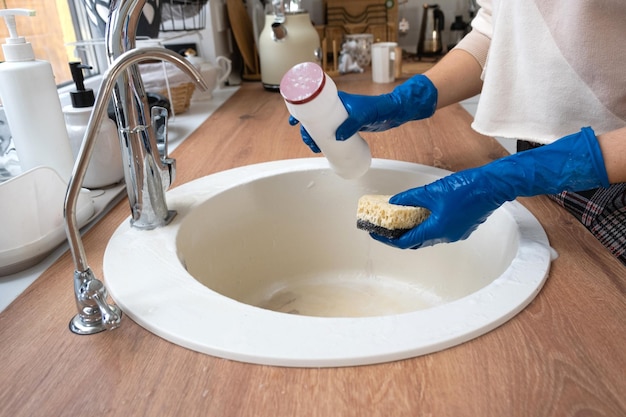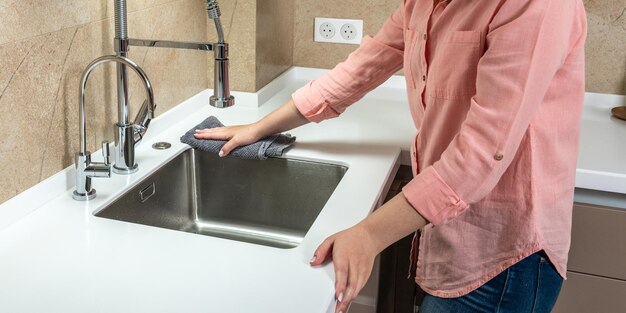Expert Sink and Drain Deep Cleaning Tips for a Healthier Kitchen
Hello there, fellow kitchen enthusiasts! Have you ever peered into your kitchen sink only to realize that it’s not exactly the gleaming focal point of your cooking space you imagined it would be? If so, you’re not alone. Sinks and drains often get overlooked in our daily chores, but they play a pivotal role in maintaining a fresh, hygienic kitchen environment. From rinsing vegetables to scrubbing dishes, the sink is your primary workstation. Yet, this same station can quickly become a hotspot for germs, buildup, and foul odors if left unchecked.
In my early days of living alone, I underestimated the importance of a regular cleaning routine for my kitchen sink and drain. It wasn’t until an unfortunate clog and a suspicious odor appeared that I realized: our sinks need the same consistent care we give our plates and utensils. Today, I’ll share a simple, step-by-step approach to keeping your sink, drain, and entire kitchen spick and span—along with how regular deep cleaning can make a world of difference.

Why Cleaning the Sink and Drain Is Essential
1. Hygiene and Health
Your sink handles a variety of tasks: washing produce, rinsing raw meat residue, cleaning utensils, and more. This constant contact with different foods means the potential for bacteria like E. coli and Salmonella to linger. Regularly cleaning and disinfecting your sink and drain reduces the risk of these harmful microbes thriving in your home.
2. Preventing Unpleasant Odors
There’s nothing quite like the stench of decaying food scraps in the drain. Over time, small bits of food and grease can accumulate and start to smell. A well-maintained drain and sink prevents these odors, ensuring that your kitchen always smells inviting.
3. Extending the Life of Your Plumbing
A clogged drain isn’t just frustrating—it can also damage your pipes or even lead to costly repairs if left unaddressed. Routine cleaning minimizes the risk of buildup, helping to keep your plumbing system functioning smoothly for years to come.
Tools and Materials You’ll Need
Cleaning Solutions: White vinegar, baking soda, or a gentle commercial cleaner
Scrub Brushes and Sponges: Choose brushes with sturdy bristles for deep scrubbing, and a soft sponge for delicate surfaces
Rubber Gloves: Protect your hands from harsh chemicals and hot water
Microfiber Cloths or Towels: Perfect for drying and buffing
Optional Extras: A plunger or plumber’s snake, particularly useful for tougher clogs
It’s always best to keep these items in an easily accessible spot in your kitchen. That way, you’re more likely to tackle small messes promptly before they become bigger issues.

Step-by-Step Guide to Cleaning Your Sink and Drain
Step 1: Clear and Rinse the Sink
Start by removing any dishes, food scraps, and standing water from your sink. Give the sink a quick rinse with warm water to flush away any loose debris. This is like prepping a canvas before painting—you want a relatively clean surface to work on.
Step 2: Apply Your Cleaning Solution and Scrub
Create a paste by mixing a small amount of baking soda with water or white vinegar. Spread this mixture around the sink basin and scrub using a sponge or brush. Pay close attention to corners and the area around the drain. Baking soda’s gentle abrasive properties help remove stains without damaging the sink surface.
If you prefer a commercial cleaner, choose one that’s appropriate for your sink’s material. Stainless steel sinks, for example, can handle most non-abrasive cleaners. After applying the cleaner, let it sit for a minute or two before scrubbing to loosen grime more effectively.
Step 3: Rinse and Wipe Down Surfaces
Once you’ve thoroughly scrubbed the sink basin, rinse it with warm water. Then, use a microfiber cloth or towel to dry and buff the sink. This prevents water spots from forming, especially on stainless steel or porcelain surfaces.
Step 4: Tackle the Drain
This is where things can get a bit tricky. If your drain has a removable strainer, take it out and scrub it separately. Use a mixture of baking soda and vinegar, pouring it directly into the drain. Let the fizzing action work its magic for about ten to fifteen minutes. This not only helps dissolve minor clogs but also deodorizes the drain. If you suspect a more stubborn clog deeper in the pipes, a plunger or plumber’s snake can help dislodge the blockage.
Step 5: Deodorize the Drain and Final Rinse
After letting the baking soda and vinegar fizz, flush the drain with hot water. For an extra burst of freshness, drop a few slices of lemon or citrus peels into the drain, then run hot water. It’s a simple way to keep the drain smelling clean. Lastly, give the sink a final rinse and wipe-down, leaving you with a bright, pristine surface.
Personal Experiences With Sink and Drain Maintenance
I’ll never forget the first time I neglected my sink. The drain started to give off a rancid smell—something akin to rotten eggs. I had no idea what was causing it! After a bit of Googling and trial-and-error, I discovered a soggy clump of pasta and vegetable bits stuck just beneath the drain cover. Ever since that incident, I’ve kept a small container of baking soda under the sink. Once a week, I sprinkle a little bit in the drain followed by hot water, which has kept the odors at bay.
Another personal tip: if you live in a household with multiple people, delegate tasks. Assign a rotating schedule where one person cleans the sink daily, another does a deeper drain clean once a week. Splitting responsibilities ensures no one person bears the entire burden, and it keeps the sink in top shape.

Extra Tips for a Fresher Kitchen
Regular Upkeep: Don’t wait for stains or clogs to become severe. Incorporate a quick scrub of the sink into your weekly cleaning routine.
Eco-Friendly Hacks: Vinegar and baking soda aren’t just for elementary science projects—they’re powerful cleaning agents that are safer for you and the environment.
Frequency of Deep Cleaning: Aim to do a thorough sink and drain cleaning (including disassembling parts, if necessary) every month. Alongside this, set aside time for a more extensive kitchen deep-clean—clean cabinets, wipe down appliances, and sanitize countertops to maintain a truly hygienic space.
Common Mistakes to Avoid
Overusing Harsh Chemicals
Many store-bought drain cleaners contain lye or other corrosive ingredients. While they might clear a clog, they can also damage pipes and harm the environment if used too often.
Neglecting Regular Maintenance
If you only clean when something goes wrong, you’ll spend more time and money fixing big problems than if you tackle minor issues regularly.
Forgetting Protective Gear
Always use rubber gloves when scrubbing or handling chemicals. Even natural cleaners like vinegar can irritate your skin if you’re not careful.
Final Thoughts
A clean sink and drain might not be the first things that come to mind when you envision your ideal kitchen, but these simple tasks form the foundation of a healthy, efficient, and enjoyable cooking space. They’re also cost-effective ways to extend the life of your appliances and plumbing.
If you find yourself short on time or dealing with especially stubborn buildup, remember that TaskOpus’ deep cleaning service is designed to handle these challenges. Their thorough approach includes cleaning your sink and drain from the outside in—ensuring you’re left with a hygienic, sparkling kitchen you’ll love to spend time in.
By making small, consistent efforts in your daily routine, you’ll keep your sink, drain, and kitchen in tip-top condition, ready for all your culinary adventures. Here’s to a kitchen that’s not only functional but also a joy to cook in—happy cleaning!